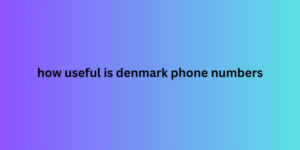Texting can help support your newsletter in several ways:
Posted: Wed Dec 11, 2024 3:50 am
Source: Online Finance
SMS alerts can increase your email open rates by reminding subscribers when you send a newsletter. While subscribers only check their email a few times a day, most people how useful is denmark phone numbers carry their phones with them at all times, so you can make sure they don't miss an email.
Creating a text to subscribe virtual number can provide a convenient additional sign up method. This is especially useful for generating newsletter opt-ins through physical media such as signs, flyers and direct mail. It only takes a few seconds to whip out your phone and send a keyword text message. Improving the sign up process is a key step in increasing the impact of email marketing.

You can also supplement your emails with SMS newsletters. This allows you to create shorter pieces of content to keep subscribers engaged during email outreach, such as breaking news or flash sale alerts, or providing quick daily tips.
4. Increase interaction
Creating opportunities to interact or engage with your newsletter content gives subscribers a reason to re-engage with your emails. Using polls and surveys to get your audience's opinion on the latest news and trends will tell you more about what your audience is interested in.
Interactions are also a great way to get your subscribers thinking about a specific topic. For example, you can ask a question relevant to your industry and include the most interesting answers in your next email.
In addition to making customers think about their own answers to your questions, even those who don’t participate will gain new perspectives from other customers.
Newsletter Strategy
Similarly, encouraging your audience to ask questions that you'll answer in your next newsletter gives subscribers an opportunity to direct content to topics they're interested in. The questions and answers you get from doing this can be a useful source for future content ideas, too. It highlights what your customers want to know more about.
5. Set the right time.
Timing has a huge impact on the success of your newsletter. The ideal schedule depends on your business and your customers, but there are some basic rules that apply to most audiences:
People often spend their weekends relaxing or having fun, without reading emails.
Avoid Mondays as well, as your recipients may have unread emails lingering from the weekend.
According to the latest data from Mailgun, emails sent at 3 p.m. on Wednesdays are most likely to be opened.
Source: MailGun
Source: Mailgun
While these rules are a starting point for your newsletter schedule, every audience has different preferences. That's why it's important to experiment with different schedules and times and regularly analyze the results to see what works best for your subscribers.
An easy way to find the right time for your customers is to ask them. A quick multiple-choice survey to choose the day, time, and frequency of emails only takes a few seconds.
SMS alerts can increase your email open rates by reminding subscribers when you send a newsletter. While subscribers only check their email a few times a day, most people how useful is denmark phone numbers carry their phones with them at all times, so you can make sure they don't miss an email.
Creating a text to subscribe virtual number can provide a convenient additional sign up method. This is especially useful for generating newsletter opt-ins through physical media such as signs, flyers and direct mail. It only takes a few seconds to whip out your phone and send a keyword text message. Improving the sign up process is a key step in increasing the impact of email marketing.

You can also supplement your emails with SMS newsletters. This allows you to create shorter pieces of content to keep subscribers engaged during email outreach, such as breaking news or flash sale alerts, or providing quick daily tips.
4. Increase interaction
Creating opportunities to interact or engage with your newsletter content gives subscribers a reason to re-engage with your emails. Using polls and surveys to get your audience's opinion on the latest news and trends will tell you more about what your audience is interested in.
Interactions are also a great way to get your subscribers thinking about a specific topic. For example, you can ask a question relevant to your industry and include the most interesting answers in your next email.
In addition to making customers think about their own answers to your questions, even those who don’t participate will gain new perspectives from other customers.
Newsletter Strategy
Similarly, encouraging your audience to ask questions that you'll answer in your next newsletter gives subscribers an opportunity to direct content to topics they're interested in. The questions and answers you get from doing this can be a useful source for future content ideas, too. It highlights what your customers want to know more about.
5. Set the right time.
Timing has a huge impact on the success of your newsletter. The ideal schedule depends on your business and your customers, but there are some basic rules that apply to most audiences:
People often spend their weekends relaxing or having fun, without reading emails.
Avoid Mondays as well, as your recipients may have unread emails lingering from the weekend.
According to the latest data from Mailgun, emails sent at 3 p.m. on Wednesdays are most likely to be opened.
Source: MailGun
Source: Mailgun
While these rules are a starting point for your newsletter schedule, every audience has different preferences. That's why it's important to experiment with different schedules and times and regularly analyze the results to see what works best for your subscribers.
An easy way to find the right time for your customers is to ask them. A quick multiple-choice survey to choose the day, time, and frequency of emails only takes a few seconds.